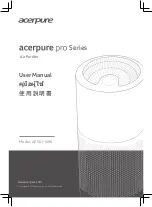
Page 5 of 9
stream in the process. It may take several hours to pull down a hot, moist building or structure on initial
startup, or anytime the system has been turned off for a long period of time. It is generally best to set the
thermostat at a comfortable temperature and let it control the system as needed, rather than turning it on
and off.
Moisture (humidity) removal with a conventional air conditioner (cooling) unit, or heat pump when operating
in the cooling mode, is not directly controlled and is a by-product of the unit operating to control temperature
in response to the temperature (thermostat) control device. Oversized equipment can easily control
temperature but will have short run-times, thus reducing its ability to remove moisture from the circulating
air stream. There are also many additional influences that can affect humidity levels within the conditioned
space such as laundry appliances, cooking, showers, exhaust fans, and any other items that can generate
moisture or affect its removal from the space. Therefore, while operation of the air conditioning or heat
pump system in the cooling mode will remove some amount of moisture as it reduces the air temperature,
precise humidity regulation in the conditioned space cannot be assured and additional equipment such as
a dedicated dehumidifier may be required.
HEAT PUMP (Air-to-Air)
A heat pump is a refrigerant-based system that has additional components and controls that both heats
and cools using a compressor for both modes of operation. Most heat pumps will also be equipped
with some amount of electric heat to supplement the heating capacity of the compressor system on an
as needed basis. This operation is entirely automatic and is controlled by the indoor thermostat, and
possibly also an outdoor thermostat.
COOLING MODE
The cooling mode of a heat pump is exactly the same as that described for an Air Conditioner in the
above section.
HEAT PUMP (HEATING MODE)
The system operates in reverse cycle, meaning that it absorbs and moves heat from the outdoors
and transfers it indoors to be rejected into the circulating air stream. Even though it seems cold to
humans, there is usable heat that can be extracted efficiently from the outdoor air down to 0
degrees F, although the colder the air is there is less heat to extract and the operating efficiency is
diminished.
DEFROST CYCLE
When operating in the heating mode, the outdoor coil will be colder than the outdoor air that is forced
over it by the fan system. When the outdoor air temperature is above approximately 40°F, moisture
can accumulate on the coil and it will drain down and out the base of the unit. As the air temperature
gets below approximately 40°F, the coil temperature will start to drop below 32°F, and frost or ice will
begin to form on the coil.
An automatic defrost system keeps track of system run time when the outdoor coil temperature is in
the freezing zone, and will initiate a defrost cycle at the appropriate time. The unit continues to
operate during the defrost cycle, but the outdoor fan motor will stop and the reversing valve will shift
positions to flow hot refrigerant gas through the outdoor coil to melt the accumulated frost. Water will
start to drain freely from the unit, and there may be steam emit from the unit.
Содержание FUSION-TEC WR Series
Страница 2: ......
Страница 50: ......
Страница 53: ......
Страница 63: ......
Страница 69: ...Manual 2100 479 Page 6 of 11 FIGURE 1 TYPICAL AIR CONDITIONING SYSTEM COOLING CYCLE MIS 369...
Страница 70: ...Manual 2100 479 Page 7 of 11 FIGURE 2 TYPICAL HEAT PUMP SYSTEM COOLING CYCLE MIS 368...
Страница 75: ......
Страница 80: ...Manual 2110 1547E Page 5 of 20 This page intentionally left blank...
Страница 84: ...Manual 2110 1547E Page 9 of 20 This page intentionally left blank...
Страница 96: ......
Страница 100: ......
















































